Overview of Resonant Converters
Definition and Classification
There is a category of power converters known as resonant converters. These converters transfer energy by utilizing the resonant action of inductors and capacitors. Additionally, their capacity to produce high efficiency and power density by minimizing switching losses distinguishes them. This is one of their defining characteristics.
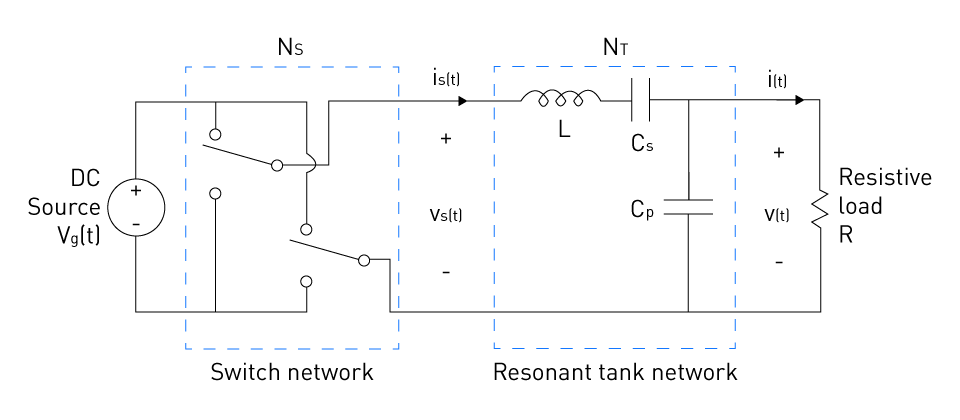
Figure 1: Resonant Converter Basic Circuit
At the switching frequency fs, the output voltage and current of the resonant tank are basically sinusoids when compared to one another. The switching frequency can be altered to control the output of the resonant tank. You can achieve this by adjusting the switching frequency to either approach or deviate from the tank's resonant frequency.
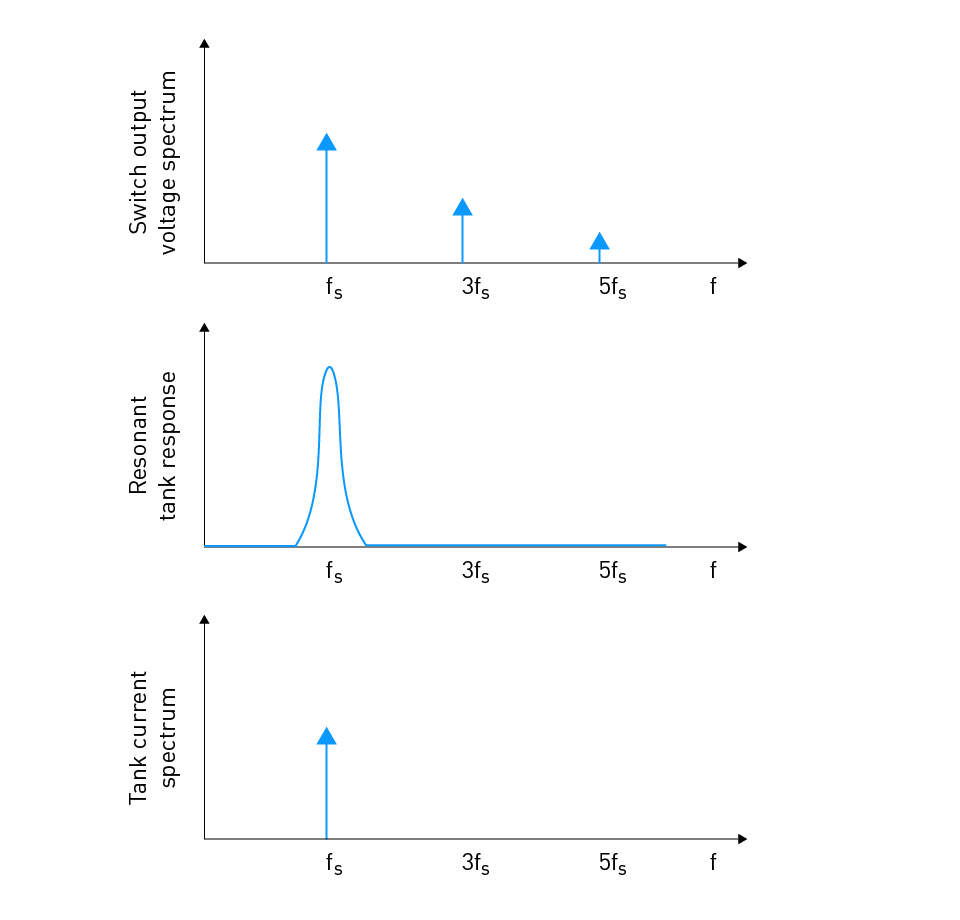
Figure 2: Frequency Response
The resonant tank's gain fluctuates based on the frequency and the load applied to its secondary side. It is necessary for designers to tune these parameters in order to guarantee that the converter functions effectively across a wide variety of loads. Designers achieve this by engineering the tank's gain to exceed a value of 1 for all load values.

Figure 3: Resonant Gain Response Across a Range of Loads
Resonant converters fall into three categories based on the configurations of their resonant parts: series, parallel, and series-parallel (LLC) resonant converters of the series variety.

Figure 4: Resonant Tank Topologies
A series resonant converter connects the load in series with the resonant inductor and the resonant capacitor. A parallel resonant converter is defined by placing the resonant capacitor in parallel with the load.
The series-parallel topology, which also incorporates components of both series and parallel resonant circuits, combines these characteristics of series and parallel resonant circuits.
The LLC resonant converter is particularly noteworthy due to its wide range of load adaptability and efficiency. Each topology has its own distinct operational characteristics, but the LLC resonant converter stands out. It is possible to build the power switches in LLC converters using either a full-bridge or a half-bridge topology approach.
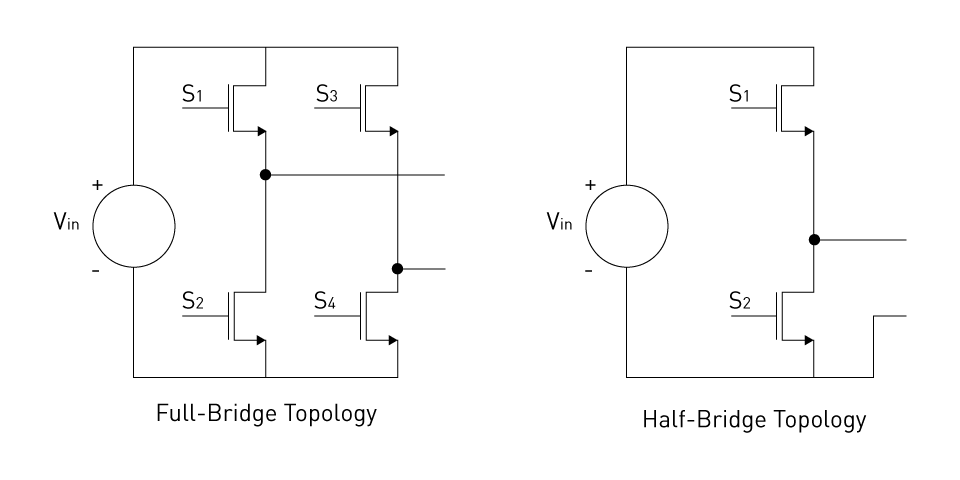
Figure 5: Power Switch Topologies
One of the most fundamental ideas behind resonant converters is that they make use of the inherent resonant frequency of inductors and capacitors in the circuit in order to achieve zero-voltage or zero-current switching. This allows for higher switching frequencies and minimizes the energy loss typically associated with switching transitions in conventional converters.
Operating Principles
Soft switching is accomplished through the utilization of the resonance that exists between inductors and capacitors, which is the fundamental operating concept of a resonant converter. The term "soft switching" refers to a technique in which the power switch transitions either from or to a state of zero current or zero voltage. This reduces switching losses and electromagnetic interference (EMI) to a large degree.
An LLC resonant converter commonly uses an LLC tank circuit with two inductors and one capacitor. This circuit is normally comprised of three components. Thanks to this arrangement, it is possible for the converter to achieve zero-voltage switching in a wide variety of operating circumstances, resulting in the converter being extremely efficient.

Figure 6: Schematic of an LLC Resonant Tank
An LLC resonant converter can operate in both continuous conduction mode (CCM) and discontinuous conduction mode (DCM). These modes are distinguished by the load that is being applied to the converter. Under heavy loads, the current flowing through the inductor in CCM never drops below zero, making it an ideal system. On the other hand, direct current mode (DCM), in which the inductor current ceases to exist, is suitable for conditions with a light load.
These converters frequently use the frequency modulation approach to adjust the output voltage. This technique involves varying the switching frequency in relation to the resonant frequency throughout the converter. This technology provides the LLC converter with an exceptional range of regulation and high efficiency across a variety of load circumstances.
Benefits of LLC Resonant Converters
Efficiency Advantages
LLC resonant converters have a well-deserved reputation for their excellent efficiency. The soft-switching techniques employed in these converters primarily contribute to their great efficiency. These techniques significantly reduce switching losses. Soft-switching reduces energy loss during the switching process by enabling power switches to function in or near zero-voltage or zero-current conditions.
The fact that LLC converters are resonant gives them the ability to modify their frequency of operation in an adaptive manner so that it is in line with the load requirements. This dynamic adjustment ensures that the converter continues to operate at its highest possible efficiency across a broad spectrum of load situations. This is in contrast to conventional converters, which may experience a considerable decrease in efficiency when operating under light loads.
When it comes to the high efficiency of LLC resonant converters, reduced electromagnetic interference (EMI) is another important component that contributes to overall efficiency. The strategy of soft switching naturally generates less electromagnetic interference (EMI), which reduces the requirement for intensive filtering and, as a result, further improves overall efficiency.
Enhanced Performance Characteristics
When compared to other types of converters, LLC resonant converters have performance characteristics that are superior. One of the most important advantages of their performance is that they have a versatile input voltage range, which makes them suited for applications in which the input conditions are uncertain or variable.
Additionally, these converters have an excellent transient response, which is an essential characteristic for applications that require rapid adjustments to load changes or fluctuations. This responsiveness ensures the converter and the attached load maintain a stable function even in rapidly changing settings.
The design of LLC resonant converters provides an inherent high power density. Furthermore, the reduction in component stress, combined with the ability to employ smaller, more efficient components, makes it possible to build converters that are more compact and lightweight.
The robustness and dependability of LLC converters are other significant characteristics of these devices. Both soft-switching and appropriate operating conditions minimize the stress on components, thereby extending the converter's lifespan and reducing the risk of failure.
Comparison with Other Converter Types
Contrasting Features and Applications
Multiple characteristics set resonant converters apart from conventional converters such as buck, boost, or flyback converters. In particular, LLC types of resonant converters are particularly notable. The fundamental mode of operation is one of the most important differences between them. Resonant converters are able to transmit energy more effectively than conventional converters because they make use of the resonance of inductors and capacitors. Conventional converters function by directly controlling either the voltage or the current.
LLC resonant converters minimize switching losses and reduce electromagnetic interference (EMI) due to their energy transfer method. This is in contrast to non-resonant converters, which can be a source of major worry due to switching losses and electromagnetic interference (EMI), particularly at higher frequencies.
Additionally, LLC resonant converters are famed for their capacity to manage higher power densities than other converters. The power supplies for servers and the equipment used in telecommunications are two examples of applications that frequently make use of them. These applications place a premium on efficiency and small design. On the other hand, classical converters might be more suitable for applications that are less complicated and less expensive, specifically those in which the high efficiency of resonant converters is not as important.
Suitability Based on Requirements
The application's requirements play a significant role in determining whether or not LLC resonant converters are suitable for use in comparison to traditional configurations. When it comes to situations in which great efficiency is of the utmost importance, particularly when the load conditions are changeable, an LLC resonant converter is frequently the preferable option. Because of its capacity to maintain a high level of efficiency across a wide range of operating circumstances, it is ideally suited for applications such as high-end power supplies and renewable energy systems.
On the other hand, classical converters might be a better option for applications in which cost is a more important consideration than efficiency or in which the power requirements are considered to be relatively low. There is a possibility that these converters are easier to develop and install, which makes them suited for consumer electronics and other applications that require low power.
The complexity of the design is another factor to take into consideration. The design process for LLC resonant converters can become more complex due to the need to properly tune the resonant components. This level of complexity may not be justified in many applications, particularly those in which the performance advantages of resonant conversion are not discernible.


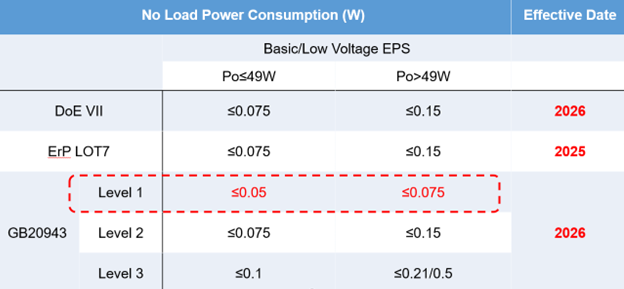

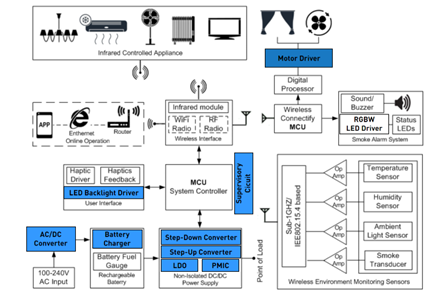

直接登录
创建新帐号